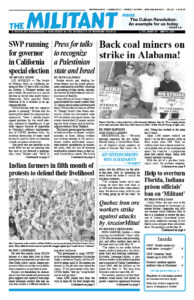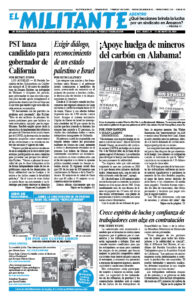Rocket attacks and shelling between Hamas and the Israeli government continued in mid-May, resulting in mounting civilian deaths, injuries, destruction of neighborhoods and displacement of families.
Since officials of Gaza’s Islamist regime initiated the armed conflict May 10, Hamas and its allies had fired more than 3,700 missiles at Israel as of May 19. Though Israel’s Iron Dome anti-missile system has intercepted some 90% of rockets crossing its border, the attacks have killed 12 people, including two Arab citizens and several immigrant workers from Thailand.
The Israeli government has retaliated with airstrikes on Hamas’ military positions in Gaza, killing civilians and leveling housing in the process. Hamas leaders deliberately concentrate military installations in residential areas, with the aim of arousing world public opinion when, as they intend, Israeli forces attack. The Israeli regime says that 130 of the more than 200 dead are Hamas or Islamic Jihad combatants. Gaza’s health ministry says that 63 children and 35 women are among those killed.
Hamas cynically claims its rocket attacks support protests over the threatened and unjust eviction of 13 Arab households in East Jerusalem’s Sheikh Jarrah neighborhood and Israeli police presence at Jerusalem’s Al-Aqsa Mosque.
Protests had been growing in anticipation of a May 6 Supreme Court hearing, now postponed, on evictions of Palestinians who have lived in Sheikh Jarrah since the 1950s. Israeli cops used rubber bullets, water cannon and arrests to break up Palestinian protests at the mosque, injuring some 200 people May 7.
Ultra-rightist groups — some linked to followers of the late Rabbi Meir Kahane, who won a few seats in the recent Knesset elections — staged reactionary actions in East Jerusalem April 22, chanting “Death to Arabs.” Police arrested some of the rightists and dispersed their demonstrations.
On May 10 small groups of Palestinian youth, waving Palestinian and Hamas flags and throwing stones and firebombs, attacked Jewish residents, homes, a school and a synagogue in Lod, a city where Jews and Arabs have lived together for years. Arab Israeli Mousa Hassouna was shot and killed by armed Jewish residents.
That evening Hamas began its rocket attacks aimed at civilian areas across Israel. The Israeli government responded with strikes on Hamas’ network of tunnels, command centers, missile factories and weapons storages in Gaza. Tens of thousands of Palestinians were driven from their homes, and civilians were killed.
Tens of thousands of Palestinians responded to a call for a general strike inside Israel and on the West Bank May 18 to protest the Israeli strikes in Gaza, attacks at the Al-Aqsa Mosque and threatened evictions. In many areas, most shops were shuttered.
Many liberals and middle-class radicals worldwide have responded by organizing actions in the U.S. and elsewhere echoing Hamas’ anti-Semitic slogan, “From the river to the sea, Palestine will be free,” a call for the destruction of Israel and driving Jews out. They’ve said nothing about the thousands of missiles launched by Hamas and Islamic Jihad against civilians in Israeli cities and towns.
The liberal imperialist media has joined in the campaign against Israel. One example is particularly telling. When an Israeli airstrike destroyed a building said by the Israeli government to house a Hamas intelligence center along with offices of the Associated Press and Al Jazeera, AP president and CEO Gary Pruitt claimed, “We have had no indication Hamas was in the building.” (Israeli officials had alerted occupants an hour in advance, allowing them to get out before the building was hit.)
As far back as a 2014 article in the Atlantic magazine, however, a former AP editor in Jerusalem reported that AP officials not only knew of the group’s presence but also that Hamas fired rockets from right near the building but decided to report nothing about it.
Jewish-Arab solidarity in Israel
As Hamas began its rocket barrage, anti-Jewish attacks as well as anti-Arab violence spread to “mixed” cities in Israel.
Yigal Yehoshua, a 56-year-old Jewish resident of Lod, died May 17. He was hit in the head by a brick hurled at him there May 11. “Yigal was a paragon of coexistence,” his wife Irena told Israel’s Channel 12 news. “He worked as an electrician and repaired homes for all, Arabs and Jews.”
Saeed Mousa, an Arab man savagely beaten by a mob of Jewish rightists in Bat Yam May 12, was hospitalized in serious condition. The rightist rioters also vandalized an Arab-owned ice cream parlor. The next day crowds of Jewish well-wishers flocked to the store to show solidarity. Jewish and Arab workers alike were aghast at these attacks. There are numerous instances where Jews protected Arab neighbors or co-workers facing rightist mobs and Arabs who protected their Jewish neighbors.
Lod resident Nisim Dahan, 72, told the Wall Street Journal that his lifelong Arab friends protected him from arsonists. “Jews and Arabs are destined to live with each other,” he said.
In Tiberias May 12, when a rightist mob headed toward the bus station looking for Arabs to beat up, “the Jewish drivers informed their Arab co-workers and hid them,” Yaniv Bar Ilan told the Militant by phone May 15. Bar Ilan is a spokesperson for Koach la Ovdim (Power to the Workers), a trade union federation that represents the drivers.
While police blocked the rightists from getting into the terminal, the cops then left many Arab bus drivers trapped in the station, unable to get home to celebrate the end of the Ramadan month of fasting. Jewish co-workers in the union, together with local residents, organized to get the Arab drivers home safely.
Many of the Jewish bus drivers support the government of Benjamin Netanyahu, Bar Ilan said. “But they understand the need for solidarity,” he added. “There is an understanding of the need to work together in the union. It’s truly amazing.”
Diplomatic relations
In the last year of the Donald Trump administration, the governments of the United Arab Emirates, Sudan, Morocco, Bahrain and Kosova established diplomatic relations with Israel. This reversal of treating Israel as a pariah state strengthened prospects for the one development that can offer a way out of decades of conflict dividing working people in the region — negotiations between Israel, Palestinian groups in Gaza and the West Bank, and Arab governments for mutual recognition of Israel and of a sovereign Palestinian state.
The recent diplomatic moves — called the Abraham Accords — were popular among many Jews and Arabs inside Israel and the Palestinian West Bank.
Some Democratic Party voices blame the growing recognition of Israel for the latest crisis. Liberal New York Times columnist Michelle Goldberg claims that the accords allowed the Israeli government to ignore the just demands of Palestinians, who face discrimination in jobs, housing and education in Israel, fueling the current explosions.
In fact, the accords presented openings that made it more possible for Palestinians to win allies and fight for improved conditions inside Israel and beyond. But reactionary forces in Israel and the region — including the clerical-bourgeois rulers in Tehran, who sponsor reactionary political forces and militias in Syria, Lebanon, Yemen, as well as Gaza — have been emboldened by the lack of progress since Joseph Biden took possession of the White House. Instead of encouraging more Arab governments to enter talks with Israel, Biden has focused on efforts to revive the Iran nuclear accords negotiated by the Barack Obama administration.
Developments unfolding in the Middle East, underline what the Socialist Workers Party pointed out in a 2017 statement, “the political necessity for the Israeli and Arab governments and leaderships of Palestinian organizations to begin immediate talks to recognize both Israel and an independent Palestinian state.
This is the road to opening the door to the class struggle, to fight for “the class interests and solidarity of workers and toiling farmers across the Middle East — be they Palestinian, Jewish, Arab, Kurdish, Turkish, Persian or otherwise, and whatever their religious or other beliefs — as well as working people in the United States and around the world.”

